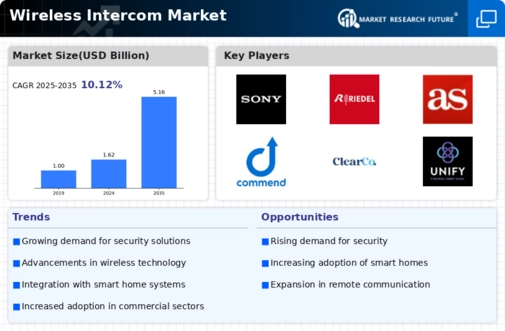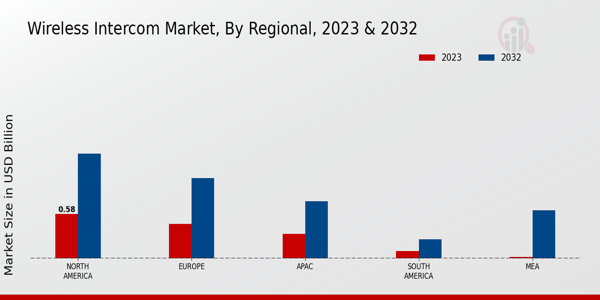Market Growth Projections
The Global Wireless Intercom Market Industry is projected to experience substantial growth over the coming years. The market is expected to reach 1.62 USD Billion in 2024, with a remarkable increase anticipated by 2035, potentially reaching 5.16 USD Billion. This growth trajectory indicates a compound annual growth rate (CAGR) of 11.12% from 2025 to 2035. Such projections highlight the increasing reliance on wireless communication systems across various sectors, driven by technological advancements and rising consumer demand for enhanced communication solutions. The market's expansion reflects broader trends in connectivity and the ongoing evolution of communication technologies.
Expansion of Smart Home Technologies
The expansion of smart home technologies significantly influences the Global Wireless Intercom Market Industry. As more consumers adopt smart home devices, the integration of wireless intercom systems with these technologies becomes increasingly prevalent. This trend allows for enhanced convenience and control, enabling users to manage their communication systems alongside other smart devices. The growing popularity of home automation is likely to drive the demand for wireless intercoms, as consumers seek cohesive solutions that streamline their daily activities. The market's growth trajectory suggests that this integration will continue to be a key factor in shaping consumer preferences and driving sales.
Growing Focus on Security and Surveillance
The emphasis on security and surveillance is a critical driver for the Global Wireless Intercom Market Industry. With rising concerns about safety in both residential and commercial spaces, wireless intercom systems are increasingly integrated with security features such as video monitoring and access control. This integration not only enhances security but also provides users with peace of mind. As urbanization continues to rise globally, the demand for effective security solutions is expected to grow. Consequently, the market is poised for expansion, as consumers and businesses alike prioritize safety and surveillance capabilities in their communication systems.
Increased Adoption in Commercial Applications
The Global Wireless Intercom Market Industry is witnessing increased adoption in commercial applications, particularly in sectors such as hospitality, healthcare, and education. Businesses are recognizing the value of efficient communication systems in enhancing customer service and operational efficiency. For instance, hotels utilize wireless intercoms for staff coordination, while healthcare facilities employ them for patient monitoring and communication among staff. This trend is expected to contribute to the market's growth, as organizations invest in communication solutions that improve service delivery. The anticipated growth from 1.62 USD Billion in 2024 to 5.16 USD Billion by 2035 illustrates the potential for expansion in this segment.
Rising Demand for Enhanced Communication Solutions
The Global Wireless Intercom Market Industry is experiencing a notable surge in demand for advanced communication solutions. This trend is driven by the increasing need for seamless communication in various sectors, including residential, commercial, and industrial applications. As organizations seek to improve operational efficiency and enhance security measures, wireless intercom systems are becoming essential tools. The market is projected to reach 1.62 USD Billion in 2024, reflecting a growing recognition of the importance of reliable communication systems. Furthermore, the anticipated growth rate suggests that by 2035, the market could expand to 5.16 USD Billion, indicating a robust trajectory for the industry.
Technological Advancements in Wireless Communication
Technological advancements play a pivotal role in shaping the Global Wireless Intercom Market Industry. Innovations such as Voice over Internet Protocol (VoIP) and integration with smart home systems enhance the functionality and appeal of wireless intercoms. These advancements not only improve audio and video quality but also facilitate remote access and control, making them increasingly attractive to consumers. As technology continues to evolve, the market is likely to witness a significant increase in adoption rates. The projected compound annual growth rate (CAGR) of 11.12% from 2025 to 2035 further underscores the potential for growth driven by these technological innovations.






















